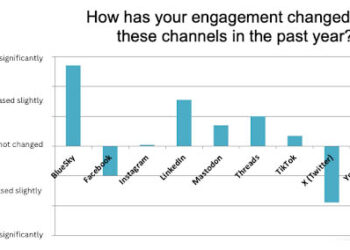Morgan Stanley has updated its Internet trends report. You can view it below:
Some interesting items stand out on what has become the de facto publishing medium for scholarly publishers:
- Consumers rule! Not only will consumer Internet bandwidth traffic surpass business, consumer software available publicly now often beats enterprise software for reliability, features, and sophistication.
- Email is increasingly archaic, as it ages with its primary user group. Younger users prefer other messaging techniques.
- The Internet now beats personal sources as an important source of information. We rely on it more now than we do on people we know. This is a major difference.
- The widgetization and componentization of the Web means more disparate presentations of previews and specialized applications in customized environments.
- Amazon.com dominates online retail — by a large margin.
- YouTube has grown in both raw traffic and the time each user spends on the site. TV executives are probably quite nervous about this trend.
- Mobile is a major, rising source of complementary and even primary information access.
The message I take from all of this? Mainly, I feel a sense of urgency. Our users are ahead of us, and moving faster than we are. The software they are becoming accustomed to using online is more robust and stable than high-end enterprise software.
In an environment where users are morphing, their changes are well-supported, and there is no intrinsic switching cost from one form of usage (old) to another (new), the risk to current brands seems to me very high. Marginalization is a real potential. Invisibility due to technological irrelevancy (not being where people are or usable in ways people prefer) is an emerging threat.
Get busy. This is no time to be paralyzed in old mental models of online, or tentative about experiments. This is only speeding up, and the U.S. recession may actually accelerate the transformation. Consumers are getting and using the best software for video, audio, telephony, shopping, and sharing. The commercial systems of PayPal, Amazon.com, eBay, and others are slick and reliable.
We are going to look like comparative cavemen if we continue to push content via HTML and email.
Discussion
2 Thoughts on "New Internet Trends — Social, Mobile, Robust, and Profitable"
Amen!
Kent I’m curious about #3. This could represent a real opportunity for publishers.
Every bit of market research I’ve ever seen for physician behavior has consultation with a peer as their number one source of information. If #3 is true for physicians, this actually represents a potential foot in the door that may not have been as relevant in the past!
Ann
I agree. Web 2.0 is about the Web becoming social. Part of what is driving this change is partially the fact that people can effectively collaborate or draw on community knowledge online, so turning online is more and more like turning to your colleagues. I think this will only increase, as this dialog illustrates!
Great comment. Thanks, Ann.



